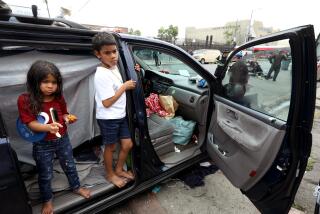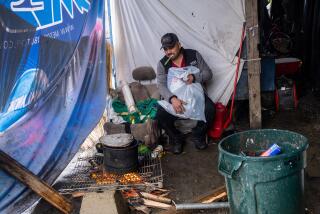Campaign for L.A.’s homeless reaches out to younger activists
We see a video on the Internet and it makes us melt or fume or cry. Sometimes, we respond en masse and change lives overnight.
Thanks to one video campaign, a 9-year-old boy who made a cardboard arcade in East L.A. has received more than enough money to one day go to college.
Thanks to another, a 68-year-old school bus monitor verbally bullied by a pack of middle schoolers probably now can afford to get off the bus for good.
We see things on the screen and we act, in part because it’s so easy. At our keyboards, on our cellphones, we can with a handful of clicks beam out help.
What’s right in front of us is different. Sometimes we don’t see. Sometimes we choose not to see. Sometimes we see but have no idea what to do.
Take the homeless people many of us pass daily on city sidewalks and freeway ramps.
Make eye contact or not? Give money or not? Is passing cash out the car window enabling?
A lot of us mull these questions and, failing to resolve them, do nothing.
The nonprofit Weingart Center on skid row wants that to change. It needs private donations to help pay for its programs to move the homeless toward self-sufficiency by training them for work, providing them counseling and finding them jobs and housing. Public money often requires private matching funds, and it doesn’t cover some of the center’s efforts.
But private donations outside of foundations are hard to come by, said Kevin Murray, the center’s chief executive.
“It’s hard to sell homelessness. It’s not sexy,” Murray said. “It’s not the big dinner where the big star shows up.”
Generally, individual private donors are older and wealthy and write big checks.
“Clearly, we’re not getting money from young folks,” Murray said.
So his organization has decided to reach out to a younger audience on its own terms, with a campaign designed to be linked to and tweeted and clicked on and Facebook-liked — and to educate them on the breadth of homelessness in Los Angeles.
The campaign is centered on the pro bono work of David & Goliath, an El Segundo-based creative agency, which does commercial campaigns for Kia Motors, Universal Studios and the California Lottery. It asks people to donate $10 by text message.
Last November, D&G, with the help of Grandesign Media Services, filmed two different projects in downtown Los Angeles.
Both featured volunteers who once were homeless. Both used street art that made passersby stop in their tracks. Both spoke of the more than 50,000 people living on the L.A. County streets.
One had a grim message, one a more hopeful one.
In front of City Hall and Walt Disney Concert Hall and other spots around downtown, open cardboard coffins were lined up. Some were placed vertically, with volunteers standing inside them. Some were placed horizontally, with volunteers lying down. Next to the coffins, a cardboard sign read: “Every day in L.A., one person who sleeps on the street dies there,” and directed people to the Weingart Center’s website.
In the arts district, as volunteers curled up on the sidewalk or leaned their backs against brick walls, a young artist drew around them in chalk. He drew a bed around a woman lying on the pavement, and drew a cozily curtained window above the bed.
As a man slouched against a wall, the artist cradled him in a chalk wingback chair and ottoman, a chalk floor lamp and books by his side and framed chalk portraits above his head.
Beside each tableau vivant was a cardboard sign that read, “TEXT THEM HOME: Text ‘HOMELESSLA’ to 20222 to donate $10 to the Weingart Center.”
Young people may not have much to give but they often like the idea of participating in crowd-funding and in playing a small part in something big, said Jordy Altman, 26, the digital media coordinator for the Weingart Center.
The center’s plan is to widely disseminate photographs and video of the projects and to get local television stations to air spots.
The dream is that the campaign will go viral.
“We’re trying to reach this younger demographic, used to being the sort of slacktivist, to watching YouTube and saying, ‘Oh, that’s neat. Oh, this is cool. Oh, that’s fun.’ We’re hoping with the mobile donation campaign, they realize how easy it is do something more, that taking that extra step is not that complicated,” Altman said.
John Stevens, 22, the artist who drew the chalk living spaces, says the campaign’s message worked for him.
“A lot of people, they just walk by homeless people on the streets. I’m guilty of doing that,” he said. “But this changed my outlook. It made me start thinking. It made me think that people don’t have to live this way.
“I showed a bunch of my friends and they thought it was awesome,” he added.
It shouldn’t take this kind of effort to make us see the need closest to home. But it does.
nita.lelyveld@latimes.com
twitter.com/latimescitybeat
More to Read
Sign up for Essential California
The most important California stories and recommendations in your inbox every morning.
You may occasionally receive promotional content from the Los Angeles Times.











